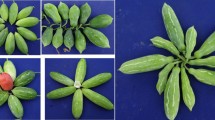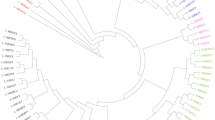Abstract
Clusterbean (Cyamopsis tetragonoloba (L.) Taub.) is commonly known as guar, a legume with drought hardiness suited to arid regions remained a neglected and underutilized crop till the shale rush began, of late it got momentum in the international market, and it became one of the most promising industrial crops in India. Seeds of clusterbean are used for extraction of gum which is called guar gum or guaran. Guar gum—a galactomannan polysaccharide—has many uses such as in the oil and petroleum industries (shale energy production or oil fracking), food industries, pharmaceutical industries, paper industries and mining fields. India is the major producer and exporter of guar to the world market. There is a tremendous variability available in Indian clusterbean germplasm, our objective of the present study to characterize and evaluate the Indian clusterbean genotypes using morphological qualitative traits. Forty-two genotypes collected across India were characterized for seven morphological traits: stem type, growth habit, leaflet texture, leaflet margin, leaflet size, flower colour and seed colour across three locations during kharif (rainy season) 2013. Coefficients of variation and principal component analysis revealed variability among the genotypes for the qualitative traits evaluated. PCA analysis showed that genotypes namely PNB, T local, HGS 884, RGC 471, MRSG6 were very different from each other. Cluster analysis separated genotypes into two major groups: one of vegetable genotypes (PNB, T local, M local, HVG2-30 and Amrit 11), and the other of gum genotypes. Among the gum genotypes RGC1066, RGC197 and FS277 formed a distinct sub cluster as they possess single stems (unbranched type), while the genotypes with white flower colour namely RGC936 and RGC471 formed a different sub cluster. The genotype MRSG6 showed brown seed with distinct grade of N 200 B which was distinctly unique and differed from the predominant grey-seeded group Correlation analysis among the traits showed that leaflet texture (pubescence) and leaflet shape (narrow) correlated highly with gum genotypes, on the contrary glabrous broad leaflets were linked with vegetable genotypes.



Similar content being viewed by others
References
APEDA (2014) http://www.apeda.gov.in/apedawebsite/SubHead_Products/Guargum.htm
Department of Agriculture and Cooperation, MoA, GoI (2014). http://agricoop.nic.in
Emami MK, Sharma B (1999) Linkage between three morphological markers in lentil (Lens culinaris Medik.). Plant Breed 118:579–581
Fletcher R, Murphy H (1998) The new rural industries: a handbook for farmers and investors. Canberra, Australia, pp 343–346
Hammer O, Harper DAT, Ryan PD (2001) PAST: paleontological statistics software package for education and data analysis. Palaeontol Electr 4:1–9
Hymowitz T (1965) Studies on guar (Cyamopsis tetragonoloba (L.) Taub.). Plant breeding abstracts 36:365
Kruskal JB (1978) Factor analysis and principal component analysis: bilinear methods. In: Kruskal WH, Tannur JM (eds) International encyclopedia of statistics. The Free Press, New York, pp 307–330
Kumar S, Joshi UN, Singh V, Singh JV, Saini ML (2013) Characterization of released and elite genotypes of guar (Cyamopsis tetragonoloba (L.) Taub.) from India proves unrelated to geographical origin. Genet Resour Crop Evol. doi:10.1007/s10722-013-9970-7
McCormick KM, Norton RM, Eagles HA (2009) Phenotypic variation within a fenugreek (Trigonella foenum-graecum L.) germplasm collection. II. Cultivar selection based on traits associated with seed yield. Genet Resour Crop Evol 56:651–661
Morris JB (2007) Swordbean (Canavalia ensiformis (L.) DC.) genetic resources regenerated for potential medical, nutraceutical and agricultural traits. Genet Resour Crop Evol 54:585–592
Morris JB (2008) Macrotyloma axillare and M. uniflorum: descriptor analysis, anthocyanin indexes, and potential uses. Genet Resour Crop Evol 55:5–8
Morris JB (2009) Characterization of butterfly pea (Clitoria ternatea L.) accessions for morphology, phenology, reproduction and potential nutraceutical, pharmaceutical trait utilization. Genet Resour Crop Evol 56:421–427
Morris JB (2010) Morphological and reproductive characterization of guar (Cyamopsis tetragonoloba) genetic resources regenerated in Georgia, USA. Genet Resour Crop Evol 57:985–993
NIAM (2014) An Analysis of Guar Crop in India - A study report. Jaipur, CCS NIAM, p 9
Paroda RS, Saini ML (1978) Guar breeding. In: Paroda RS, Arora RN (eds) Guar: its improvement and management. Forage Res 4:9–39
Pearson K (1901) On lines and planes of closest fit to systems of points in space. Philos Mag A 6:559–572
Purseglove JW (1981) Leguminosae. Tropical crops: Dicotyledons. Longman Group Ltd., Essex, pp 250–254
Rosso BS, Pagano EM (2001) Collection and characterization of naturalized populations of white clover (Trifolium repens L.) in Argentina. Genet Resour Crop Evol 48:513–517
Rubio J, Cubero JI, Martin LM, Suso MJ, Flores F (2004) Biplot analysis of trait relations of white lupin in Spain. Euphytica 135:217–224
Rumbaugh MD, Graves WL, Caddel JL, Mohammad RM (1988) Variability in a collection of alfalfa germplasm from Morocco. Crop Sci 28:605–609
Shannon CE, Weaver W (1949) The mathematical theory of communication. Univ. of Illinois Press, Urbana
Sivakumar (2002) Characterization of cluster bean cultivars using laboratory techniques and field parameters. M.Sc. thesis, Haryana Agricultural University, Hisar
Sultan M, Rabbani MA, Shinwari ZK, Masood MS (2012) Phenotypic divergence in guar (Cyamopsis tetragonoloba L.) landrace genotypes of Pakistan. Pak J Bot 44:203–210
Tanksley SD (1983) Molecular markers in plant breeding. Plant Mol Biol Rep 1:3–8
Ward JH (1963) Hierarchical grouping to optimize an objective function. J Am Stat Assoc 58:236–244
Zada M, Zakir N, Rabbani MA, Shinwari ZA (2013) Assessment of genetic variation in Ethiopian mustard (Brassica carinata A. Braun) germplasm using multivariate techniques. Pak J Bot 45(S1):583–593
Acknowledgments
The work presented in this paper is a part of the PhD work carried out by A. Manivannan at the Department of Plant Breeding and Genetics, Agricultural College and Research Institute, Madurai, Tamil Nadu, India. The support provided by Indian Council of Agricultural Research (ICAR) by awarding an ICAR-Senior Research Fellowship (ICAR-SRF) and also granting study leave to him and extending facilities at ICAR-Indian Institute of Maize Research, New Delhi, is gratefully acknowledged.
Author information
Authors and Affiliations
Corresponding author
Rights and permissions
About this article
Cite this article
Manivannan, A., Anandakumar, C.R., Ushakumari, R. et al. Characterization of Indian clusterbean (Cyamopsis tetragonoloba (L.) Taub.) genotypes using qualitative morphological traits. Genet Resour Crop Evol 63, 483–493 (2016). https://doi.org/10.1007/s10722-015-0266-y
Received:
Accepted:
Published:
Issue Date:
DOI: https://doi.org/10.1007/s10722-015-0266-y




